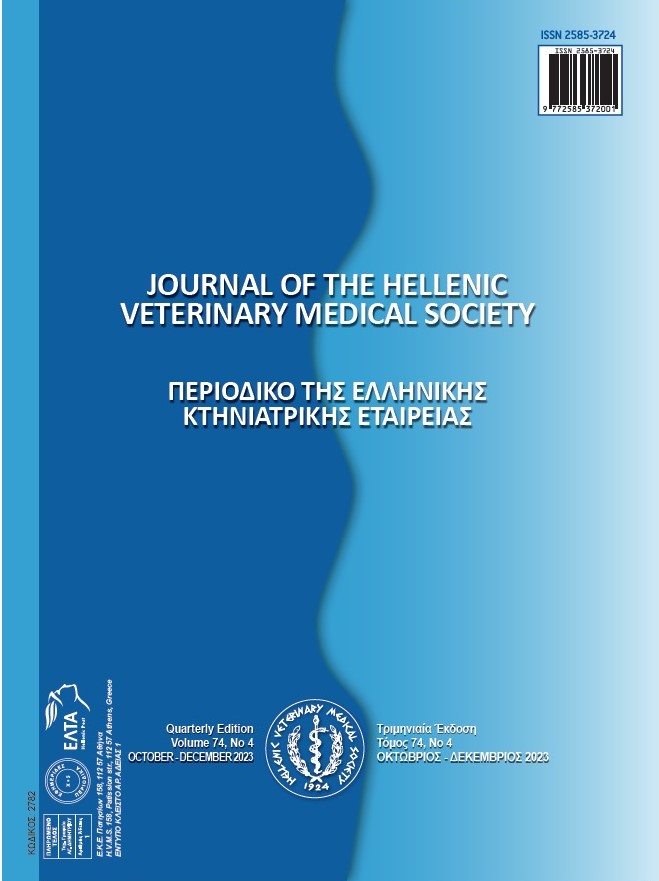Thoracic and abdominal aortic dissection in a hypertensive hyperthyroid cat

Abstract
Aortic dissection is an uncommon finding in both dogs and cats. The precise pathophysiological mechanisms responsible for the development of aortic dissection remain unclear. In humans, aortic dissection is usually secondary to another systemic disease, such as systemic arterial hypertension, an abnormality of connective tissues or a parietal trauma. This is a case of an aortic dissection in a hypertensive hyperthyroid cat, presenting with haemorrhagic pericardial effusion. The dissection affected both thoracic and abdominal aorta, with histopathological confirmation. This case is an example of the utility of both thoracic and abdominal ultrasound for the diagnosis of aortic dissection in cats and it highlights the importance of rigorous clinical examination. Aortic dissection should be considered in the differential diagnosis of pericardial effusion in cats. Further investigations are fundamental to understand how dissections develop and extend to achieve good clinical results.
REFERENCES
- Braverman et al. (2012) Diseases of the aorta. In: Braunwald’s Heart Disease. A textbook of cardiovascular medicine. 9th Eds Bonow R, Mann D, Zipes D, Libby P. Elsevier Saunders, Philadelphia, pp 1319-1331.
- Chetboul et al. (2006) Quantitative assessment of velocities of the annulus of the left atrioventricular valve and left ventricular free wall in healthy cats by use of two-dimensional colour tissue Doppler imaging. Am. J. Vet. Res. 2006, 67: 250-258.
- Cojocaru et al. (2013) Evaluation of oxidative stress in patients with acute ischemic stroke. Romanian Journal of Internal Medicine. 51(2):97-106.
- D’Ancona et al. (2014) Computational analysis to predict false-lumen perfusion and outcome of type B aortic dissection. The Journal of Thoracic and Cardiovascular Surgery. 148 (4):1756-1758.
- Gouni et al. (2018) Aortic dissecting aneurysm associated with systemic arterial hypertension in a cat. Schweiz Arch Tierheilkd. 160(5):320-324.
- Liao et al. (2008) A proteomic study of the aortic media in human thoracic aortic dissection: implication for oxidative stress. Journal of Thoracic and Cardiovascular Surgery. 136(1):65-72.
- Liu et al. (2016) Ursodeoxycholic acid attenuates acute aortic dissection formation in angiotensin II-infused apolipoprotein E-deficient mice associated with reduced ROS and increased Nrf2 levels. Cellular Physiology and Biochemistry. 38(4): 1391-1405.
- Phillippi et al. (2009) Basal and oxidative stress-induced expression of metallothionein is decreased in ascending aortic aneurysms of bicuspid aortic valve patients. Circulation. 119(18):2498-2506.
- Qin et al. (2016) Dynamic monitoring of platelet activation and its role in post-dissection inflammation in a canine model of acute type A aortic dissection. Journal of Cardiothoracic Surgery. 11(1):86.
- Qing et al. (2012) Ex-vivo haemodynamic models for the study of Stanford type B aortic dissection in isolated porcine aorta. European Journal of Vascular and Endovascular Surgery. 44(4):399-405.
- Waldrop et al. (2003) Aortic dissection associated with aortic aneurysms and posterior paresis in a dog. Journal of Veterinary Internal Medicine. 17(2):223-229.
- Wang et al. (2013) An experimental model of Stanford type B aortic dissection with intravenous epinephrine injection. Kaohsiung Journal of Medical Sciences. 29(4):194-199.
- Wey AC, Atkins CE (2000). Aortic dissection and congestive heart failure associated with systemic hypertension in a cat. Journal of Veterinary Internal Medicine. 14(2):208-213.
Article Details
- How to Cite
-
Veciana Basse, C., & Testault, I. (2024). Thoracic and abdominal aortic dissection in a hypertensive hyperthyroid cat. Journal of the Hellenic Veterinary Medical Society, 74(4), 6731–6736. https://doi.org/10.12681/jhvms.31764
- Issue
- Vol. 74 No. 4 (2023)
- Section
- Case Report

This work is licensed under a Creative Commons Attribution-NonCommercial 4.0 International License.
Authors who publish with this journal agree to the following terms:
· Authors retain copyright and grant the journal right of first publication with the work simultaneously licensed under a Creative Commons Attribution Non-Commercial License that allows others to share the work with an acknowledgement of the work's authorship and initial publication in this journal.
· Authors are able to enter into separate, additional contractual arrangements for the non-exclusive distribution of the journal's published version of the work (e.g. post it to an institutional repository or publish it in a book), with an acknowledgement of its initial publication in this journal.
· Authors are permitted and encouraged to post their work online (preferably in institutional repositories or on their website) prior to and during the submission process, as it can lead to productive exchanges, as well as earlier and greater citation of published work.


